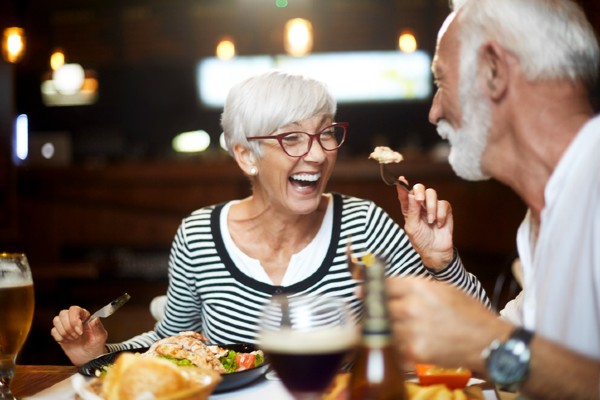Good nutrition is important at every age. It’s key for seniors in particular, who tend to be less active, have a slower metabolism, and absorb and use fewer nutrients. Because of this, their nutrition needs are even higher. But it’s estimated that almost half of older Americans are malnourished, according to the Administration for Community Living.
A number of factors can cause seniors to eat less, putting them at an increased risk of diabetes, heart disease, high blood pressure, osteoporosis and other illnesses.
Find out more about the nutrition needs of seniors, what to expect from a typical senior meals menu, dining options, and service when living at a senior community, and how Senior Lifestyle communities offer senior dining choices to help their residents stay healthy.
Why Is Nutrition a Concern for Seniors?
Even when food is available and options are provided, seniors may have a more difficult time getting proper nutrition. Among the factors that make it harder are:
- Depression – A combination of factors may lead to depression, which may cause a lack of appetite
- Difficulties at home – Seniors may be limited by suddenly living alone or having trouble with mobility
- Income – Not having enough money for food is a common problem
- Medicines – Prescriptions can change how food tastes, make a mouth dry, or supress appetite
- Other physical problems – A loss of smell or taste, or problems chewing or swallowing, can limit food intake
- Poor health – This can make it harder for seniors to cook or feed themselves
- Reduced social contact – Solitary adults may not enjoy meals as much without people joining them
Getting the right foods in the right variety is vital to keep seniors healthy. A proper eating plan for seniors includes:
- Breads, crackers, rice, pasta or whole-grain cereals
- Fruits and vegetables
- Low-fat or fat-free dairy fortified with vitamin D
- Polyunsaturated and monounsaturated fats.
- Protein, including fish, beans and peas along with meat and poultry

Download The Complete Guide to Senior Housing
Every senior has their own set of wants and needs, so retirement communities offer differing levels of care, services, and amenities. Read our eBook for a detailed look at what retirement communities provide.
Download the GuideOne of the solutions to the problem of senior dining and nutrition is to get help and oversight at a senior community. Meals at these communities specialize in the nutritional needs of older folks.
What Services Are Provided at Senior Lifestyle Communities?
The dining experience is vital in the lives of residents at Senior Lifestyle communities. Each meal represents an opportunity to socialize, make connections, and build relationships with neighbors.
At Senior Lifestyle communities, residents are called upon for their feedback on the dining experience and to provide recipes to be included in each community’s weekly menus. According to David Cyplik, Corporate Director of Dining Services for Senior Lifestyle, many of these resident recipes have become a popular offering in communities.
Residents at Senior Lifestyle communities will also experience:
- 2-3 meals a day – This depends on the resident’s meal plan or level of care. Residents in Independent Living can get two or three meals a day, or can purchase meals a la carte. Assisted Living and Memory Care residents are provided three meals.
- Formal and informal meals – Choose chef-prepared sit-down meals or grab-and-go options
- Healthy snacks – Available all day
- Large dining rooms – Residents can meet friends and invite family to a lively meal
- Locally-sourced foods – This gives residents fresher, healthier options
- Mealtime assistance – Residents don’t have to struggle with eating
- Professional waiting team members – They can attend to a resident’s needs
- Room service – For if residents prefer the quiet of their own residence
Residents are invited to talk to our team members about how we can cater to their nutritional, dietary and taste preferences.
What Dining Amenities Are Provided at Senior Lifestyle Communities?
The dining options don’t end with what is served at Senior Lifestyle communities. In many of our communities, residents can look forward to high-end and casual dining.
Among the typical eating options for residents are:
- Outdoor dining – Featuring a wide array of creative and inviting outdoor spaces, including outdoor dining patios and fire pits.
- Private dining room – The ideal location to relax and socialize with friends in a cozier setting.
- Public dining room – Featuring chef-prepared menus that change seasonally and feature flavorful, locally-grown produce. Often featuring daily continental breakfast and Sunday brunch.
- Tavern – A full-service bar with bistro-style dining is an ideal choice when looking for a casual meal in a warm setting. Offers convenient to-go options.
Some locations will also offer additional restaurants on premises.
>> Read 5 Nutritional Benefits of Retirement Community Living
Find Out More About Senior Lifestyle Communities
Senior Lifestyle can offer insight on what to expect from typical menus, dining options, and service when living at a senior community.
Reach out today to learn more about our community lifestyles.

